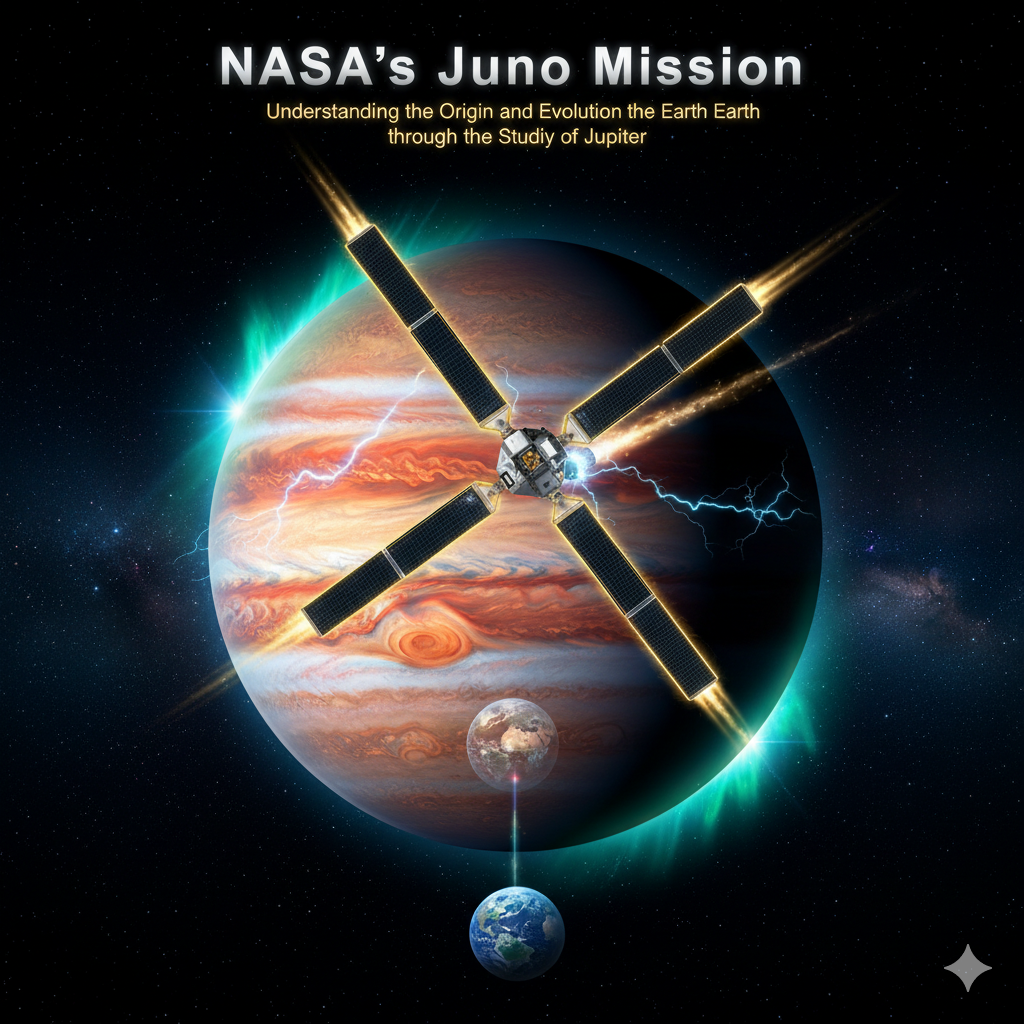Introduction
The exploration of space has always been driven by humanity’s desire to answer some of the most fundamental questions: Where did we come from? How did the Earth form? How did our solar system evolve into what it is today? NASA’s Juno Mission, which was launched in 2011 and entered Jupiter’s orbit in July 2016, is one of the most ambitious scientific endeavors aimed at answering these very questions. While Juno is specifically designed to study Jupiter, the largest planet in our solar system, its findings provide profound insights into the origin, evolution, and nature of Earth and other terrestrial planets.
Jupiter is often referred to as the “king of planets” because of its massive size and influence. It contains more than twice the mass of all other planets in the solar system combined. Its gravity, composition, and dynamic atmospheric system hold clues about the early solar system. Scientists believe that by studying Jupiter, especially its atmosphere, magnetic field, and core, we can uncover valuable information about the conditions under which Earth formed more than 4.5 billion years ago.
This article explores the Juno mission, its objectives, instruments, findings, and how those discoveries are helping scientists understand the origin and evolution of Earth.
1. The Context: Why Jupiter Matters in Understanding Earth’s Origin
1.1 Jupiter as a Time Capsule of the Early Solar System
Unlike Earth, which has undergone immense geological, atmospheric, and biological changes, Jupiter has preserved much of its original composition. Being primarily made of hydrogen and helium—the same elements that formed the Sun—it acts as a time capsule, storing information about the early solar nebula from which all planets emerged.
Studying Jupiter allows scientists to:
- Understand the distribution of elements in the early solar system.
- Learn how gas giants formed and influenced the migration of smaller planets.
- Identify the role Jupiter played in protecting or destabilizing early Earth.
1.2 Jupiter’s Gravitational Role
Jupiter’s immense gravity has shaped the solar system in profound ways:
- It deflected comets and asteroids that could have bombarded early Earth.
- It influenced the orbital paths of smaller bodies, which affected the delivery of water and organic compounds to Earth.
- Its movements in the early solar system might have influenced the position and stability of the terrestrial planets.
Thus, by decoding Jupiter’s secrets, scientists indirectly learn about the factors that shaped Earth’s emergence as a habitable planet.
2. The Juno Mission: Overview
2.1 Mission Timeline
- Launch Date: August 5, 2011, from Cape Canaveral.
- Arrival at Jupiter: July 4, 2016.
- Mission Extension: Originally planned for 20 months, but extended multiple times (current operations extend beyond 2025).
2.2 Mission Objectives
NASA designed Juno with a set of specific scientific goals, many of which tie directly to Earth’s story:
- Determine Jupiter’s origin and evolution.
- Investigate the composition of Jupiter’s atmosphere, especially water and ammonia content.
- Explore Jupiter’s magnetic field and magnetosphere.
- Study the structure of Jupiter’s core.
- Understand the dynamics of Jupiter’s auroras and their implications for planetary magnetic interactions.
2.3 Why the Name “Juno”?
In Roman mythology, Juno was the wife of Jupiter. While Jupiter (the god) was known for hiding behind clouds, Juno could peer through them and reveal the truth. Similarly, NASA’s Juno spacecraft peers through the dense clouds of the planet Jupiter to uncover hidden truths about its structure and formation.
3. Instruments on Juno and Their Role
Juno carries nine scientific instruments, each contributing to a different aspect of understanding Jupiter and, by extension, Earth’s origins.
3.1 Microwave Radiometer (MWR)
- Measures microwave emissions from Jupiter’s atmosphere.
- Provides data on water and ammonia abundance, which is crucial because the availability of water in the early solar system is linked to Earth’s oceans.
3.2 Jovian Infrared Auroral Mapper (JIRAM)
- Studies infrared emissions from auroras.
- Helps in understanding the energy dynamics of the upper atmosphere.
3.3 Magnetometer (MAG)
- Measures the magnetic field with great precision.
- Provides insight into dynamo processes within Jupiter’s core—this helps compare with Earth’s magnetic field generation.
3.4 Gravity Science Instrument
- Tracks tiny variations in Juno’s orbit caused by gravitational pull.
- Helps determine the distribution of mass inside Jupiter, offering clues about whether it has a solid core.
3.5 JunoCam
- A public outreach camera providing visible-light images.
- Though primarily designed for engagement, it has delivered valuable scientific data on Jupiter’s cloud structures.
3.6 Waves, JADE, UVS, and JEDI Instruments
- These instruments study plasma, particles, and auroras.
- Help understand Jupiter’s magnetosphere, which can be compared to Earth’s protective magnetosphere.
4. Major Discoveries of Juno and Their Implications for Earth
4.1 Water and the Origin of Earth’s Oceans
One of Juno’s major goals was to measure the abundance of water in Jupiter’s atmosphere. Since Earth’s oceans may have originated from icy bodies influenced by Jupiter’s gravity, understanding Jupiter’s water content sheds light on how Earth became a water-rich planet.
Findings show that water is more abundant at Jupiter’s equator than previously thought. This suggests that the early solar system had significant water distribution, some of which reached Earth through cometary and asteroid impacts.
4.2 Jupiter’s Core and Planet Formation
Juno revealed that Jupiter might not have a compact, solid core, but rather a “fuzzy” diluted core mixed with hydrogen and helium. This challenges old theories of planet formation and implies that giant impacts in the early solar system may have shaped Jupiter’s interior.
Such collisions may have been common, and similar processes could have influenced Earth’s growth during its accretion phase.
4.3 Magnetic Field Insights
Juno discovered that Jupiter’s magnetic field is far more complex and uneven than expected. Unlike Earth’s relatively stable dipole field, Jupiter’s is irregular, with extremely strong localized regions.
Understanding this helps scientists refine models of planetary dynamos. Since Earth’s magnetic field is crucial for shielding life from harmful solar radiation, insights from Jupiter’s magnetism provide a comparative framework for why Earth is habitable.
4.4 Atmospheric Dynamics and Weather Systems
Juno revealed massive cyclones at Jupiter’s poles, each the size of Earth itself. Studying these gigantic weather systems helps climatologists understand atmospheric dynamics on a global scale.
These studies improve Earth climate models, as they highlight how planetary atmospheres transport heat, energy, and chemicals.
4.5 Auroras and Radiation
Juno found that Jupiter’s auroras are powered by different mechanisms than Earth’s, producing unique X-ray and radio emissions. By comparing Jupiter’s auroras with Earth’s, scientists gain deeper insights into space weather, which affects satellites, power grids, and communication systems on Earth.
5. How Juno Helps Understand Earth’s Origin and Evolution
5.1 Insights into Solar System Formation
- Juno’s data suggests that Jupiter migrated during its formation. This movement influenced the orbits of planetesimals and may have been responsible for delivering water and organic molecules to Earth.
- The information on Jupiter’s diluted core supports the theory of massive impacts shaping planetary evolution—a process Earth also underwent.
5.2 Earth’s Magnetic Protection and Habitability
- By comparing Earth’s magnetic field with Jupiter’s, scientists understand the conditions required for a stable dynamo inside planets.
- A strong magnetic field is essential for shielding life from solar winds. Juno’s study confirms how crucial Earth’s geodynamo has been in maintaining habitability.
5.3 Water Distribution and the Seeds of Life
- Juno’s findings about water in Jupiter’s atmosphere trace back to the distribution of volatiles in the solar nebula.
- Since water is central to life, knowing how it was distributed helps explain how Earth became a habitable world.
5.4 Atmospheric Comparisons and Climate Understanding
- Juno’s insights into Jupiter’s weather patterns, jet streams, and polar cyclones help improve general circulation models.
- These models are applied not just for Jupiter but for understanding Earth’s climate system and predicting long-term atmospheric changes.
6. Broader Scientific and Philosophical Implications
6.1 A Window into Exoplanetary Systems
The study of Jupiter informs us about gas giants around other stars. Since many exoplanets discovered are “hot Jupiters,” Juno’s findings help refine models of planetary migration, which also impacts whether Earth-like worlds exist in habitable zones.
6.2 Understanding Planetary Diversity
By contrasting Earth with Jupiter, scientists appreciate the diverse evolutionary pathways planets can take. This deepens our perspective on how unique Earth is as a cradle of life.
6.3 Reinforcing the Fragility of Earth
Juno’s revelations remind us of Earth’s delicate balance—its water, protective magnetosphere, and climate stability—that make it habitable. This encourages humanity to protect Earth while exploring the cosmos.
7. Challenges and Limitations of Juno
- Radiation Exposure: Jupiter’s intense radiation environment threatens spacecraft instruments.
- Orbital Constraints: Juno’s elongated orbit limits continuous observations.
- Interpretation Difficulties: Data about deep atmospheric processes is still challenging to analyze.
Despite these challenges, Juno continues to send groundbreaking information, reshaping planetary science.
8. The Future: Juno’s Legacy and Next Steps
- Juno has already been extended beyond its original mission, with new flybys of Jupiter’s moons Ganymede, Europa, and Io.
- These moons are of special interest because they may harbor subsurface oceans, offering further insight into the conditions for life.
- Juno’s legacy will inspire future missions like Europa Clipper and JUICE (Jupiter Icy Moons Explorer), which will extend our understanding of the link between giant planets and the possibility of life.
Conclusion
NASA’s Juno mission, though designed to study Jupiter, has become a window into Earth’s own past. By uncovering the mysteries of Jupiter’s atmosphere, magnetic field, and interior, Juno helps answer pressing questions about how Earth formed, why it became habitable, and how it fits into the broader story of the solar system.
Key takeaways include:
- Jupiter’s role in distributing water and shaping Earth’s habitability.
- The importance of magnetic fields in shielding life.
- The connection between giant impacts in Jupiter’s past and Earth’s own violent beginnings.
- Insights into climate systems that refine our understanding of Earth’s atmosphere.
Ultimately, the Juno mission demonstrates that to understand Earth, we must also understand our cosmic neighbors. By studying the giant planet Jupiter, humanity gains not only knowledge about the origins of the Earth but also about the broader processes that govern planetary systems, evolution, and the potential for life in the universe.




